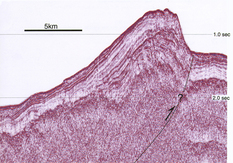Bulletin of the Geological Survey of Japan Vol.51 No.2/3 (2000)
Cover photograh | Table of Contents |
Cover photograh

Seismic profile of the Yahikotai bank, 80km north of Sado Island, Japan Sea
An asymmetric anticline on the profile is presumed to have developed by reverse faulting. It is generally very difficult to observe faults on seismic profiles, thus we generally draw a reverse fault like a dotted line. Recently, relationships between faults and folds have been clarified, which makes possible to infer fault geometry and amount of slip from the analysis of the fold geometry. (see Okamura in this issue)
Table of Contents
Special Issue:Evaluation of earthquake potential in offshore areas – reviews of geological approaches –
| Title | Author | |
|---|---|---|
| Preface | Yukinobu OKAMURA (47) | 51-0203_01.pdf(147KB) |
| Analyses of active faults in shallow marine and lake areas – case studies and arguments about | Kohsaku ARAI (49-58) | 51-0203_02.pdf(2,181KB) |
| Identification of offshore active faults on seismic profiles – application of fault related fold, growth strata and growth triangle – | Yukinobu OKAMURA (59-77) | 51-0203_03.pdf(4,972KB) |
| Initiation processes of turbidity currents: implications for assessment of recurrence intervals of offshore earthquakes using turbidites | Takeshi NAKAJIMA (79-87) | 51-0203_04.pdf(1,226KB) |
| Paleoseismicity analysis using earthquake-induced sediments | Ken IKEHARA (89-102) | 51-0203_05.pdf(2,738KB) |
| Interaction between subducting seamounts and overriding forearc wedges, and its relation to large earthquakes: a review | Toshitsugu YAMAZAKI (103-111) | 51-0203_06.pdf(3,375KB) |
Geological Survey of Japan, AIST
- About GSJ
- Our Activities
- Purchase guide
-
Publications and Database
- information
- Bulletin of the Geological Survey of Japan
- bull2025(Vol.76)
- bull2024(Vol.75)
- bull2023(Vol.74)
- bull2022(Vol.73)
- bull2021(Vol.72)
- bull2020(Vol.71)
- bull2019(Vol.70)
- bull2018(Vol.69)
- bull2017(Vol.68)
- bull2016(Vol.67)
- bull2015(Vol.66)
- bull2014(Vol.65)
- bull2013(Vol.64)
- bull2012(Vol.63)
- bull2011(Vol.62)
- bull2010(Vol.61)
- bull2009(Vol.60)
- bull2008(Vol.59)
- bull2007(Vol.58)
- bull2006(Vol.57)
- bull2005(Vol.56)
- bull2004(Vol.55)
- bull2003(Vol.54)
- bull2002(Vol.53)
- bull2001(Vol.52)
- Bulletin of the Geological Survey of Japan(old)
- Annual Report on Active Fault and Paleoearthquake Researches
- Reports, Geological Survey of Japan
- CCOP-GSJ Groundwater Project Report
- CCOP Technical Bulletin
- Cruise Report
- Geological Hazards
- Learning and Education
- GSJ Database Collection
- Collection of links

